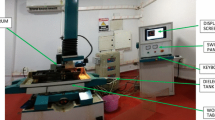Abstract
A white layer is considered a major flaw on a workpiece surface machined with wire-cut electrical discharge machining (WEDM). In this paper, an attempt has been made to model the white layer depth through response surface methodology (RSM) in a WEDM process comprising a rough cut followed by a trim cut. An experimental plan for rotatable central composite design of second order involving four variables with five levels has been employed to carry out the experimental investigation and subsequently to establish the mathematical model correlating the input process parameters with the response. Pulse on time during rough cutting, pulse on time, wire tool offset, and constant cutting speed during trim cutting are considered the dominant input process parameters whilst the white layer depth is the response. An insignificant “lack of fit” term indicated a curve with a good fit. Also, an extensive analysis of the influences of all the individual input parameters on the response has been carried out and presented in this research study.
Similar content being viewed by others
References
Kahng CH, Rajurkar KP (1997) Surface characteristics behaviour due to rough and fine cutting by EDM. Ann CIRP 25(1):77–82
Kruth JP, Stevens L, et al. (1995) Study of the white layers of a surface machined by die-sinking electro-discharge machining. Ann CIRP 44(1):169–172
Spedding TA, Wang ZQ (1997) Study on modelling of wire EDM process. J Mater Process Technol 69:18–28
Huang JT, Liao YS (1997) A study of finish-cutting operation number and machining parameters setting in wire electrical discharge machining. Proceedings of the International Conference on Precision Engineering (ICPE 97), pp 671–676
Huang JT, Liao YS, Hsue WJ (1999) Determination of finish- cutting operation number and machining parameters setting in wire electrical discharge machining. J Mater Process Technol 87:69–81
Rebelo JC, et al. (1998) Influence of EDM pulse energy on the surface integrity of martensitic steels. J Mater Process Technol 84:90–96
Cochran WG, Cox GM (1957) Experimental designs, 2nd edn. John Wiley & Sons, Inc., New York 10016
Puri AB, Bhattacharya B (2002) An analysis and optimisation of the geometrical inaccuracy due to wire lag phenomenon in WEDM. Int J Mach Tools Manuf 43(2):151–159
Puri AB, Bhattacharyya B, Sorkhel SK (2000) Taguchi method based experimental studies for controlled CNC wire-EDM operation. Proc. of 19th All India Manufacturing Technology Design and Research Conference (AIMTDR), India, pp 173–178
Author information
Authors and Affiliations
Corresponding author
Rights and permissions
About this article
Cite this article
Puri, A., Bhattacharyya, B. Modeling and analysis of white layer depth in a wire-cut EDM process through response surface methodology. Int J Adv Manuf Technol 25, 301–307 (2005). https://doi.org/10.1007/s00170-003-2045-8
Received:
Accepted:
Published:
Issue Date:
DOI: https://doi.org/10.1007/s00170-003-2045-8




